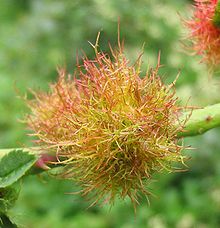Diplolepididae: Difference between revisions
→top: ce |
m clean up, typo(s) fixed: the the → the |
||
| Line 17: | Line 17: | ||
'''Diplolepididae''' is a family of small [[Gall|gall-inducing]] wasps. Until recently these wasps were included in the [[Cynipidae|gall wasp family (Cynipidae)]] but were moved to their own family based on genetic and morphological features.<ref name=blaimer>{{Cite Q|Q102333857}}</ref><ref name=hearn>{{Cite Q|Q123440111}}</ref> It contains two subfamilies: [[Diplolepidinae]] and [[Pediaspidinae]].<ref name="hearn" /> |
'''Diplolepididae''' is a family of small [[Gall|gall-inducing]] wasps. Until recently these wasps were included in the [[Cynipidae|gall wasp family (Cynipidae)]] but were moved to their own family based on genetic and morphological features.<ref name=blaimer>{{Cite Q|Q102333857}}</ref><ref name=hearn>{{Cite Q|Q123440111}}</ref> It contains two subfamilies: [[Diplolepidinae]] and [[Pediaspidinae]].<ref name="hearn" /> |
||
Diplolepidinae includes about 60 species in two [[Genus|genera]] ([[Diplolepis (wasp)|''Diplolepis'']] and ''[[Liebelia]]''), all of which induce [[gall]]s on [[ |
Diplolepidinae includes about 60 species in two [[Genus|genera]] ([[Diplolepis (wasp)|''Diplolepis'']] and ''[[Liebelia]]''), all of which induce [[gall]]s on [[rose]]s in which the larvae live and feed.<ref name="hearn" /><ref name=ronquist>{{Cite Q|Q28647214}}</ref><ref name=zhang>{{Cite Q|Q99634248}}</ref> This subfamily was formerly included in Cynipidae as the tribe Diplolepidini.<ref name="hearn" /> |
||
Pediaspidinae is composed of two [[Monotypic taxon|monotypic]] genera: ''[[Himalocynips]]'' and ''[[Pediaspis]]''.<ref name="hearn" /> The biology of this subfamily is poorly known, though ''[[Pediaspis aceris]]'' induces galls on a species of [[maple]].<ref name="hearn" /> This subfamily was formerly included in Cynipidae as |
Pediaspidinae is composed of two [[Monotypic taxon|monotypic]] genera: ''[[Himalocynips]]'' and ''[[Pediaspis]]''.<ref name="hearn" /> The biology of this subfamily is poorly known, though ''[[Pediaspis aceris]]'' induces galls on a species of [[maple]].<ref name="hearn" /> This subfamily was formerly included in Cynipidae as the tribe Pediaspini.<ref name="hearn" /> |
||
== References == |
== References == |
||
| Line 26: | Line 26: | ||
{{Taxonbar|from=Q123476903}} |
{{Taxonbar|from=Q123476903}} |
||
| ⚫ | |||
[[Category:Hymenoptera families]] |
[[Category:Hymenoptera families]] |
||
[[Category:Cynipoidea]] |
[[Category:Cynipoidea]] |
||
[[Category:Gall-inducing insects]] |
[[Category:Gall-inducing insects]] |
||
| ⚫ | |||
Revision as of 11:21, 19 November 2023
| Diplolepididae | |
|---|---|

| |
| Diplolepis rosae gall | |
| Scientific classification | |
| Domain: | Eukaryota |
| Kingdom: | Animalia |
| Phylum: | Arthropoda |
| Class: | Insecta |
| Order: | Hymenoptera |
| Superfamily: | Cynipoidea |
| Family: | Diplolepididae Latreille, 1802 |
| Genera | |
| |
Diplolepididae is a family of small gall-inducing wasps. Until recently these wasps were included in the gall wasp family (Cynipidae) but were moved to their own family based on genetic and morphological features.[1][2] It contains two subfamilies: Diplolepidinae and Pediaspidinae.[2]
Diplolepidinae includes about 60 species in two genera (Diplolepis and Liebelia), all of which induce galls on roses in which the larvae live and feed.[2][3][4] This subfamily was formerly included in Cynipidae as the tribe Diplolepidini.[2]
Pediaspidinae is composed of two monotypic genera: Himalocynips and Pediaspis.[2] The biology of this subfamily is poorly known, though Pediaspis aceris induces galls on a species of maple.[2] This subfamily was formerly included in Cynipidae as the tribe Pediaspini.[2]
References
- ^ Bonnie B. Blaimer; Dietrich Gotzek; Seán G Brady; Matthew L Buffington (23 November 2020). "Comprehensive phylogenomic analyses re-write the evolution of parasitism within cynipoid wasps". BMC Ecology and Evolution. 20 (1): 155. doi:10.1186/S12862-020-01716-2. ISSN 1471-2148. PMID 33228574. Wikidata Q102333857.
{{cite journal}}: CS1 maint: unflagged free DOI (link) - ^ a b c d e f g Jack Hearn; Erik Gobbo; José Luis Nieves-Aldrey; et al. (3 October 2023). "Phylogenomic analysis of protein-coding genes resolves complex gall wasp relationships". Systematic Entomology. doi:10.1111/SYEN.12611. ISSN 0307-6970. Wikidata Q123440111.
- ^ Fredrik Ronquist; José-Luis Nieves-Aldrey; Matthew L Buffington; Zhiwei Liu; Johan Liljeblad; Johan A A Nylander (2015). "Phylogeny, evolution and classification of gall wasps: the plot thickens". PLOS One. 10 (5): e0123301. Bibcode:2015PLoSO..1023301R. doi:10.1371/JOURNAL.PONE.0123301. ISSN 1932-6203. PMC 4439057. PMID 25993346. Wikidata Q28647214.
{{cite journal}}: CS1 maint: unflagged free DOI (link) - ^ Y. Miles Zhang; Matthew L. Buffington; Chris Looney; Zoltán László; Joseph D. Shorthouse; Tatsuya Ide; Andrea Lucky (29 August 2020). "UCE data reveal multiple origins of rose gallers in North America: Global phylogeny of Diplolepis Geoffroy (Hymenoptera: Cynipidae)". Molecular Phylogenetics and Evolution. 153: 106949. doi:10.1016/J.YMPEV.2020.106949. ISSN 1055-7903. PMID 32866614. Wikidata Q99634248.
